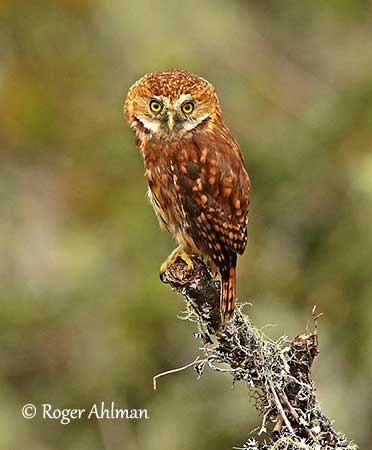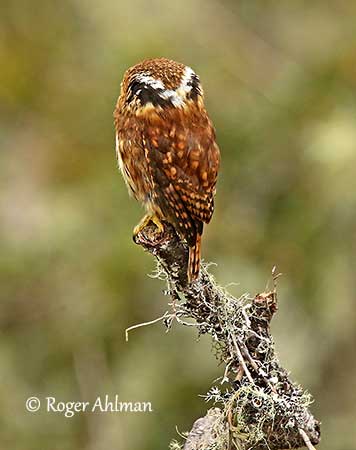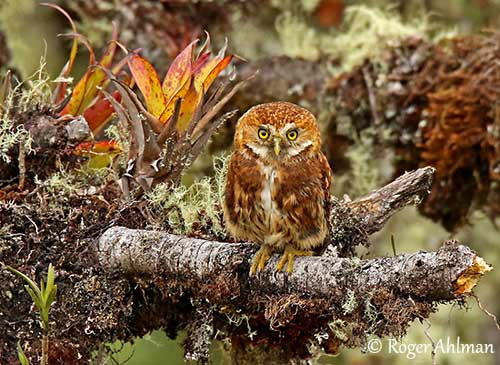
Fr: Chevêchette des yungas
Ang: Yungas Pygmy-Owl
All: Bolivienzwergkauz
Esp: Mochuelo Boliviano
Ita: Civettina della yungas
Nd: Boliviaanse Dwerguil
Sd: yungassparvuggla
Photographer:
Roger Ahlman
Pbase Galleries Peru and Ecuador & My bird pictures on IBC
Text by Nicole Bouglouan
Sources:
HANDBOOK OF THE BIRDS OF THE WORLD Vol 5 by Josep del Hoyo-Andrew Elliott-Jordi Sargatal - Lynx Edicions - ISBN: 8487334253
OWLS OF THE WORLD – By Claus König, Friedhelm Weick and Jan-Hendrik Becking - IBSN 978-0-7136-6548-2
Birds New to Science: Fifty Years of Avian Discoveries Par David Brewer – Editeur: Bloomsbury Publishing, 2018 – ISBN: 1472945891, 9781472945891 - 416 pages
Wikipedia, the free encyclopaedia
Neotropical Birds – Cornell Lab of Ornithology
Yungas Pygmy-Owl
Glaucidium bolivianum
Strigiformes Order – Strigidae Family
INTRODUCTION:
The Yungas Pygmy-Owl was described first in 1991 in the C. König’s 1991 monograph on pygmy-owls of the South American Andes. This study was based on vocalizations and the Glaucidium owls were classified in three groups. The present species is in the second group that includes owls uttering trills and single notes or only trills. This species was new for science alongside the Peruvian Pygmy-Owl or Pacific Pygmy-Owl (G. peruanum).
The Yungas Pygmy-Owl has grey, brown and rufous morphs, and the brown morph is the commonest. The rufous morph is displayed on this page.
This species frequents humid montane forest and cloud forest, from 900 metres up to 3,000 metres of elevation. It is active from dusk to dawn, but it may be vocal during daytime too. It feeds mainly on insects and various arthropods, small birds and small vertebrates and probably reptiles. It hunts in the canopy and in dense foliage.
The Yungas Pygmy-Owl is uncommon to fairly common locally. It is vulnerable to destruction and fragmentation of its habitat involving a slow decline of the population. But currently, the species is not globally threatened.
YUNGAS: Yungas are transitional areas between the Andean highlands and the eastern forest. In Peru, yungas is the ecoregion of rainforest and montane forest from 1,000 to 3,500 metres of elevation, and is limited to the E side of the Andes. It is considered as the most endemic biodiversity of Peru.

DESCRIPTION OF THE BIRD:
Biometrics:
Length: 16 cm
Weight: M: 53-58 g – F: 66-67 g
The Yungas Pygmy-Owl is a small Strigidae with large head and conspicuous “false eyes” on the nape, but the ear-tufts are absent.
The grey morph has dusky grey-brown upperparts with whitish or brownish-yellow spots. On the upperwing, some pale lines are formed by buffy-white spots on flight-feather’s webs. The tail is blackish with 5-6 whitish bars.
On the underparts, throat, centre of breast and belly are whitish. The upper breast is dusky brown whereas lower breast and belly are streaked brown.
On the head, the facial disk is pale greyish-brown with dark flecks. It is rather flat and poorly developed. The eyebrows are white. The crown is densely marked with whitish dots and larger, scaly, pale ochre markings.
On the nape, we can see two blackish “false eyes” bordered whitish above and pale ochre below. These "false eyes" are intended to deceive the predator who thinks that the bird sees it and looks at it when in fact he is turned on the other side.
Bill and cere are greenish-yellow. The eyes are golden yellow. On the legs, the tarsi are feathered and the bare feet are dull yellow with dark claws.
Male and female are similar but the female is larger than male.
The juvenile has unmarked crown and the streaking is less distinct on flanks.
The brown morph has same plumage pattern, but it is warm dark brown. The blackish tail has only five whitish bars.
The rufous morph (displayed) is rusty orange-brown overall, with similar plumage pattern. The tail is dark brown with seven rows of oval, pale orange-brown spots.
The underparts are orange-brown. Underside and throat have whitish centre.

RANGE:
The Yungas Pygmy-Owl is found on the E slope of Andes of Peru, WC Bolivia and NW Argentina.
HABITAT:
The Yungas Pygmy-Owl frequents humid, epiphytic and mossy montane forest and cloud forest with alder (Alnus) or Podocarpus, between 1,400 and 3,000 metres of elevation or higher, and occasionally down to 900 metres.
This species is most common in dense cloud forest with tangled undergrowth, at 1,000/2,500 metres.
CALLS AND SONGS: SOUNDS BY XENO-CANTO
The Yungas Pygmy-Owl gives a soft “whoeeo” as contact call, usually given at varying intervals.
The song includes two different phrases with first 2-3 melodious whistles “wüühurrr” and then, a series of slightly drawn-out, hollow notes equally spaced and given slowly “whüp-whüp-whüp-whüp”. The female utters similar song but higher-pitched. She may sometimes duets with the male.
BEHAVIOUR IN THE WILD:
The Yungas Pygmy-Owl feeds primarily on insects and various other arthropods, but it also catches small birds and probably other small vertebrates and reptiles.
It is mostly crepuscular and nocturnal, but it can be seen during daytime too. It forages mainly in the canopy, but also in the dense foliage below it.

During the breeding season, the male moves throughout its territory while singing in the canopy from exposed perch. It gives 2-3 fluted phrases followed by series a high “hoots”. During this period, several males usually sing at the same time at dusk.
The courtship displays of this recently discovered species are unknown, but we can suggest that the courtship typically involves ritualized feeding by male to female.
The Yungas Pygmy-Owl is probably resident and largely sedentary, but it may perform some altitudinal movements.
This species has long tail and rounded wings, well adapted to the habit of foraging and moving in canopy and dense foliage.
REPRODUCTION OF THIS SPECIES:
The breeding season is related to prey availability and starts in August/September in Argentina.
The Yungas Pygmy-Owl nests in cavities, often abandoned woodpecker’s holes. The nest is rather high above the ground.
The eggs are not described, but the incubation is performed by the female while the male feeds her.
PROTECTION / THREATS / STATUS:
The Yungas Pygmy-Owl is threatened by habitat destruction and fragmentation, but some parts of the range are inaccessible and should afford some protection.
The population is slowly declining but the species is described as uncommon or fairly common locally.
The Yungas Pygmy-Owl is not globally threatened and currently evaluated as Least Concern.
